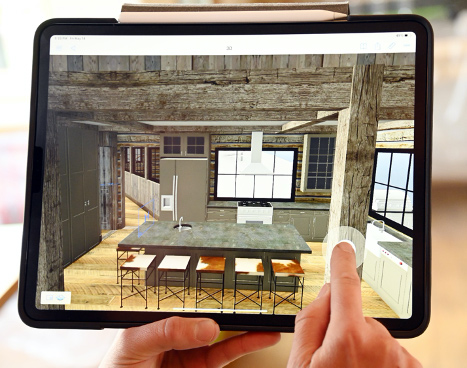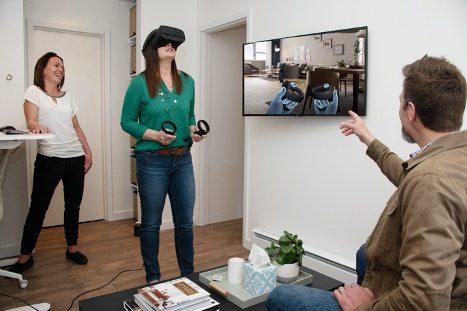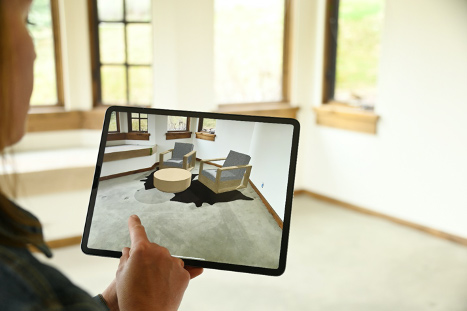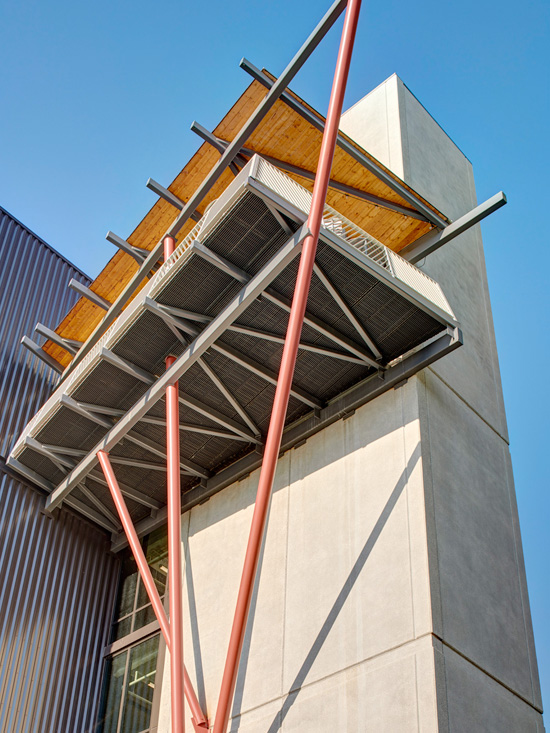January 26, 2022

In this article, Elizabeth Ellis shares the technologies that are helping her stand out from the crowd, win more projects, and prevent issues arising on the job site.
Cutting-edge technology is just one of the many tools Elizabeth Ellis Interior Design is keeping sharp these days.
Based in Ketchum/Sun Valley, Idaho, Elizabeth Ellis puts her attention and talents to work on high-end residential interior design as well as some commercial projects.
When she first used Archicad almost 18 years ago, Ellis’ work centered around elementary schools, libraries, and even prisons. Those projects lacked the need for a detail-oriented approach but helped set the framework to master the basics of interior design in Archicad. As Ellis’ career progressed to high-end residential design, the creative process shifted to include unique and specific ways to model and design “outside of the box.” To this designer, it offered a way to explore a more interesting and exciting line of work and the projects that go along with them.
Modeling in 3D was mind-boggling but felt like the right way to design. When I left that firm for another that worked in 2D, I found that incredibly inefficient and frustrating.
Elizabeth Ellis
Having worked in 2D during the early days as an interior designer, Ellis was initially caught off-guard when her first employer switched to Archicad. However, during learning sessions in Archicad, she soon adapted to working in 3D and even met the man that would later become her husband. “Working in 3D was exciting because I had spent so much time drafting in a 2D format, whether it was a pencil or AutoCAD lines. Modeling in 3D was mind-boggling but felt like the right way to design. When I left that firm for another that worked in 2D, I found that incredibly inefficient and frustrating.”
So frustrated, in fact, that Ellis, about a year ago, started her own company, Elizabeth Ellis Interior Design. And now married to an Archicad-guru; together, they channeled that frustration and fueled a deep study into all the available options of optimal design and efficient business processes.

Ellis likes to collaborate with architects on typical interior design projects, using the teamwork capability to work out details. She jumps right into Archicad. She mostly avoids the hand-sketch-to-CAD process, except when on the job site with an iPad where she’ll note up photos. “Because I can transfer those notes on the iPad directly into Archicad, I can avoid hand sketching, which is time-consuming and inefficient. Or, for renovation projects, I will use my Matterport camera to scan the entire project, then I will drop the point cloud into Archicad and start modeling from that. Either way, in Archicad, I can quickly get measurements, figure out space requirements, and start throwing things into the model and see the three-dimensional quality of the design without surprises. Tweaking something in the 3D model means there’s no need for a pencil.”
… For renovation projects, I will use my Matterport camera to scan the entire project, then I will drop the point cloud into Archicad and start modeling from that.
Elizabeth Ellis

Tools making all the Difference
Ellis uses her Archicad model to demonstrate her ideas and relies on it to help her communicate with contractors. “I was working on a custom piece of furniture, some steel shelving with a wood top, and the contractor that was putting the steel shelving together was struggling to understand the 2D elevation. In a matter of minutes, at a meeting in my office, I showed them how it was modeled in 3D, spun it around, and they understood it instantly. I jump into Archicad right from the beginning.”
Access from all areas, with BIMx
She often reduces the need to meet in her office, with the extended functionality of BIMx to convey design intent. With BIMx, as questions arise, the entire project is in a single file that can be updated with the tap of an icon. It eliminates the need to carry around a roll of plans, or extensive construction schedules, folders of product manuals, or Excel documents. “BIMx means I don’t have to bring a laptop everywhere I go. I love it for my clients because they can also have the model on their smart devices, spin around, and walk through the space virtually. They show it off to their friends and family. I’ve taken the interior design side of it one step further and incorporated live links to tear-sheets, and the contractors love it because they can have it right there in the BIMx model, on their devices on the job site. Clients can use it indefinitely for home maintenance.”
I love (BIMx) for my clients because they can also have the model on their smart devices, spin around, and walk through the space virtually.
Elizabeth Ellis

Ellis makes use of BIMx gallery views to help guide her clients through their homes. With BIMx, Ellis has the power to show multiple design options in the same BIMx file. This allows her clients to explore both options one after another.
Meetings like this can happen over a virtual platform or in person. Seeing everything modeled in this way, her clients can get a feel for the space and what it would be like in real life. She also utilizes the direct link from Archicad to Twinmotion to quickly produce photo-realistic images, which the clients absolutely love.
Taking Visuals to a new level, with VR
When the project is at the point where much has been decided, VR goggles enter the picture.
“With VR, they can walk around their house, and it scales to their body, and they can understand being in the space rather than just looking at it on an iPad. The pandemic has shown us that we don’t need to be all in the same physical space all the time to get work done. Being able to virtually experience things is becoming so much a part of how I work with my clients that it reinforces my choice to use Archicad. It works well with VR, and all interior designers can unlock this potential with the right software in their workflow.”
With VR, clients can walk around their house, and it scales to their body, and they can understand being in the space rather than just looking at it on an iPad.
Elizabeth Ellis

VR can also be used with other stakeholders to hold virtual on-site meetings. Everyone can gather inside the virtual project and walk around together to discuss the design and any issues that may need addressing. It’s incredibly accurate and is a precise preview of how the building will look and feel before a footing has even been poured.
Preventing Issues, with Archicad
The modeling capability of Archicad has helped Ellis push limits on her designs. On a current kitchen project, she is working on a unique island design that integrates stone within the wood finishes of the finished panels. Without Archicad showing her how that works in the model, she wouldn’t have discovered the flaw in the original design.
“Archicad helped me avoid fighting on the job site to be able to make it look that way that in my brain I assumed it would work. Visualizing it in the model allowed me to show how the stone attaches to these wood finishes and deliver that to the fabricator. That’s been helpful in the construction side of things in the interior furniture side of things. Clients invest in sophisticated furniture or fixtures, and they want to make sure it fits, and they want to make sure it’s right.”
Ellis uses Archicad to model exact pieces such as furniture, appliances, and even fixtures. Using the exact manufacturer’s specs for all geometry, finishes, and information, she places it into a model, later taking it to her client to see it in augmented reality.
“Again, this means there are no surprises. We know it’ll fit. We like the look of it. It feels good to them spatially in the space. That’s an added bonus in my profession – to be able to ensure that clients feel happy with the big investment of the furniture that they’re getting.”
In Archicad 25, the addition of custom objects, a huge wish list item for Ellis, has already changed how she will be modeling the cabinetry side of things. Archicad supports the work of interior designers in a way that Ellis considers to be critical.

Winning more projects, with the Archicad family
“I use Archicad for everything, and it does help me with my pitch. This area has a somewhat wealthy community, saturated with highly talented architects and interior designers. I wanted to pick a niche to stand out and break away from the crowd. I did that with technology and Archicad. I don’t take on any projects that don’t require 3D modeling because that is what sells my service. In fact, people often say they don’t need all the techy stuff, but I give it to them anyway, and they love it. Not just because it looks pretty, but because it’s information rich. It’s about giving all the stakeholders exactly what they need as a standard part of the service. Since taking Archicad as my primary software, I can claim a hundred percent hit rate on clients onboarding with me because they see the value in being able to visualize everything before they write the check, in any sense of the project.”
Looking to the future
And Ellis is excited about what the future has to offer. With the metaverse just around the corner, she is already gearing up for digital interior design in virtual spaces. The virtual worlds that make up the metaverse will require substantial amounts of architecture and there will be no real-world rules or limitations. “It’s quite an exciting time and I plan to use Archicad in developing spaces where people will love to meet, virtually.”
But for now, “it is the end-all. I use Archicad for everything”.
You might also like:

More Articles:
Archicad
Customer Stories
Education
Industry News
Tips, Resources + Downloads
Webinar Recordings